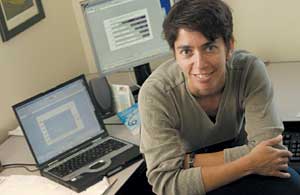Vital Signs:
DMS researcher documents incidence of needless Paps
Ten million women who have had hysterectomies are tested each year, needlessly, for cervical cancer. In most hysterectomies, the cervix as well as the uterus is surgically removed. "It doesn't make sense to screen a woman for cancer in an organ that she doesn't have," explains Dr. Brenda Sirovich, an assistant professor of medicine at DMS.
The test for cervical cancer is the Pap smear, in which a few cells from the cervix are scraped off and examined under a microscope. Since the test was invented in the 1940s, the incidence of cervical cancer has greatly declined. Yet for a woman without a cervix, the Pap has no value, as guidelines issued in 1996 by the U.S. Preventive Services Task Force pointed out.
Logic: Yet despite their intuitive logic, those guidelines have been ignored. Sirovich and Dr. H. Gilbert Welch, a professor of medicine at DMS, analyzed data on 187,670 women who'd had hysterectomies. Their source was the Behavioral Risk Factor Surveillance System, an annual telephone survey conducted by the Centers for Disease Control and Prevention. "We looked at Pap smear screening before and after the 1996 guidelines came out," Sirovich says. "The rate didn't change. It was absolutely flat."
She and Welch estimate that nearly half of the 21 million U.S. women who have had hysterectomies continue to get unnecessary Pap tests. If a hysterectomy was done because of cancer, Sirovich adds, having a regular Pap is still a good idea. But most hysterectomies are not cancer related. For these women, testing cells from the vagina, in lieu of the absent cervix, tells nothing. Vaginal cancer is very rare, and the Pap smear was not designed to find it.
Practice: "The interesting question to ask," Sirovich says, "is how did this practice evolve? I don't know. In medical school, we were taught to do vaginal smears on women who had had hysterectomies. It didn't make sense to me, but when you're in training a lot of things don't make sense."
Sirovich and Welch, who are part of the Outcomes Group at the White River Junction, Vt., VA Medical Center, published their findings in the Journal of the American Medical Association. Afterwards, Sirovich was interviewed by more than 20 news outlets, including the New York Times and the Associated Press. She also appeared on NBC's Today Show, National Public Radio, and CNN.
News: "We can be a little optimistic," she says, "that the publicity will make a difference, that the awareness of both doctors and women was raised." The feedback she's received suggests that "both parties think the other one is not willing to give up this practice that has become so universally accepted." Doctors, she explains, feel "it's hard to do less. Once people have come to accept an intervention, it's hard to take it away. And screening for cancer is apple pie. It has this intrinsic value. Doctors aren't willing to risk losing a patient's trust by stopping it."
 Photo by Jon Gilbert Fox |
| According to DMS's Brenda Sirovich, some 10 million women a year who don't need a Pap test get one anyway. |
Another factor, says Sirovich, may be "report cards" by healthmaintenance organizations. The Pap is one measure of high-quality care for women. "To the HMO," says Sirovich, "the best doctors are the ones with the highest number of Pap tests." But report card databases often don't note hysterectomies.
Finally, doctors worry that without the pull of a yearly Pap, women may not come in for a checkup. "It's something to keep in mind," Sirovich concedes, "but if it's worthwhile to see your doctor every year, it's not worthwhile to spend all your time getting an unnecessary Pap smear and discussing it. There are a lot of patient-driven issues that could benefit from having more time addressed to them.
Time: "We are not advocating stopping Pap smear screening for women who have a cervix," she emphasizes. "We just want to make the practice more rational. As doctors, we want to use our resources better—and our main resource is time."
If you would like to offer any feedback about this article, we would welcome getting your comments at DartMed@Dartmouth.edu.
